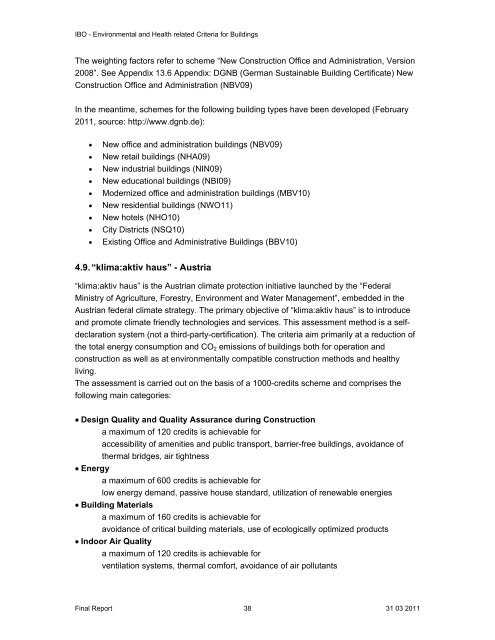Environmental and health related criteria for buildings - ANEC
Environmental and health related criteria for buildings - ANEC
Environmental and health related criteria for buildings - ANEC
Create successful ePaper yourself
Turn your PDF publications into a flip-book with our unique Google optimized e-Paper software.
IBO - <strong>Environmental</strong> <strong>and</strong> Health <strong>related</strong> Criteria <strong>for</strong> Buildings<br />
The weighting factors refer to scheme “New Construction Office <strong>and</strong> Administration, Version<br />
2008”. See Appendix 13.6 Appendix: DGNB (German Sustainable Building Certificate) New<br />
Construction Office <strong>and</strong> Administration (NBV09)<br />
In the meantime, schemes <strong>for</strong> the following building types have been developed (February<br />
2011, source: http://www.dgnb.de):<br />
• New office <strong>and</strong> administration <strong>buildings</strong> (NBV09)<br />
• New retail <strong>buildings</strong> (NHA09)<br />
• New industrial <strong>buildings</strong> (NIN09)<br />
• New educational <strong>buildings</strong> (NBI09)<br />
• Modernized office <strong>and</strong> administration <strong>buildings</strong> (MBV10)<br />
• New residential <strong>buildings</strong> (NWO11)<br />
• New hotels (NHO10)<br />
• City Districts (NSQ10)<br />
• Existing Office <strong>and</strong> Administrative Buildings (BBV10)<br />
4.9. “klima:aktiv haus” - Austria<br />
“klima:aktiv haus” is the Austrian climate protection initiative launched by the “Federal<br />
Ministry of Agriculture, Forestry, Environment <strong>and</strong> Water Management”, embedded in the<br />
Austrian federal climate strategy. The primary objective of “klima:aktiv haus” is to introduce<br />
<strong>and</strong> promote climate friendly technologies <strong>and</strong> services. This assessment method is a selfdeclaration<br />
system (not a third-party-certification). The <strong>criteria</strong> aim primarily at a reduction of<br />
the total energy consumption <strong>and</strong> CO 2 emissions of <strong>buildings</strong> both <strong>for</strong> operation <strong>and</strong><br />
construction as well as at environmentally compatible construction methods <strong>and</strong> <strong>health</strong>y<br />
living.<br />
The assessment is carried out on the basis of a 1000-credits scheme <strong>and</strong> comprises the<br />
following main categories:<br />
• Design Quality <strong>and</strong> Quality Assurance during Construction<br />
a maximum of 120 credits is achievable <strong>for</strong><br />
accessibility of amenities <strong>and</strong> public transport, barrier-free <strong>buildings</strong>, avoidance of<br />
thermal bridges, air tightness<br />
• Energy<br />
a maximum of 600 credits is achievable <strong>for</strong><br />
low energy dem<strong>and</strong>, passive house st<strong>and</strong>ard, utilization of renewable energies<br />
• Building Materials<br />
a maximum of 160 credits is achievable <strong>for</strong><br />
avoidance of critical building materials, use of ecologically optimized products<br />
• Indoor Air Quality<br />
a maximum of 120 credits is achievable <strong>for</strong><br />
ventilation systems, thermal com<strong>for</strong>t, avoidance of air pollutants<br />
Final Report 38 31 03 2011
















